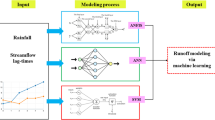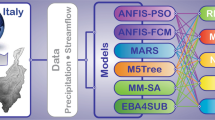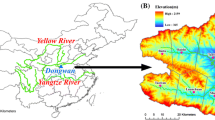Abstract
Accurate short-term rainfall–runoff prediction is essential for flood mitigation and safety of hydraulic structures and infrastructures. This study investigates the capability of four machine learning methods (MLM), optimal pruning extreme learning machine (OPELM), multivariate adaptive regression spline (MARS), M5 model tree (M5Tree, and hybridized MARS and Kmeans algorithm (MARS-Kmeans), in hourly rainfall–runoff modeling (considering 1-, 6- and 12-h horizons). Their results are compared with a conceptual method, Event-Based Approach for Small and Ungauged Basins (EBA4SUB) and multi-linear regression (MLR). Hourly rainfall and runoff data gathered from Ilme River watershed, Germany, were divided into two equal parts, and MLM were validated considering each part by swap** training and testing datasets. MLM were compared with EBA4SUB using four events and with respect to three statistics, root-mean-square errors (RMSE), mean absolute error (MAE) and Nash–Sutcliffe efficiency (NSE). Comparison results revealed that the newly developed hybridized MARS-Kmeans method performed superior to the OPELM, MARS, M5Tree and MLR methods in prediction of 1-, 6- and 12-h ahead runoff. Comparison with conceptual method showed that all the machine learning models outperformed the EBA4SUB and OPELM provided slightly better performance than the other three alternatives in event-based rainfall–runoff modeling.
Graphic abstract









Similar content being viewed by others
References
Adamowski J, Chan HF, Prasher SO, Sharda VN (2012) Comparison of multivariate adaptive regression splines with coupled wavelet transform artificial neural networks for runoff forecasting in Himalayan micro-watersheds with limited data. J Hydroinformatics 14(3):731–744
Adnan RM, Liang Z, Trajkovic S, Zounemat-Kermani M, Li B, Kisi O (2019) Daily streamflow prediction using optimally pruned extreme learning machine. J Hydrol 577:123981
Adnan RM, Yuan X, Kisi O, Adnan M, Mehmood A (2018) Stream flow forecasting of poorly gauged mountainous watershed by least square support vector machine, fuzzy genetic algorithm and m5 model tree using climatic data from nearby station. Water Resour Manag 32(14):4469–4486
Adnan RM, Liang Z, Heddam S, Zounemat-Kermani M, Kisi O, Li B (2019a) Least square support vector machine and multivariate adaptive regression splines for streamflow prediction in mountainous basin using hydro-meteorological data as inputs. J Hydrol 586:124371. https://doi.org/10.1016/j.jhydrol.2019.124371
Al-Sudani ZA, Salih SQ, Yaseen ZM (2019) Development of multivariate adaptive regression spline integrated with differential evolution model for streamflow simulation. J Hydrol 573:1–12
ASTER GDEM (2009) http://www.gdem.aster.ersdac.or.jp/
Atiquzzaman M, Kandasamy J (2016) Prediction of hydrological time-series using extreme learning machine. J Hydroinformatics 18(2):345–353
Atiquzzaman M, Kandasamy J (2018) Robustness of extreme Learning Machine in the prediction of hydrological flow series. Comput Geosci 120:105–114
CORINE (Coordination of Information on Environment) Database (2000) A key database for European integrated environmental assessment. Programme of the European Commission, European Environmental Agency (EEA)
Chou S-M, Lee T-S, Shao YE, Chen I-F (2004) Mining the breast cancer pattern using artificial neural networks and multivariate adaptive regression splines. Expert Syst Appl 27(1):133–142
Deo RC, Şahin M (2016) An extreme learning machine model for the simulation of monthly mean streamflow water level in eastern Queensland. Environ Monit Assess 188(2):90
Fan J, Yue W, Wu L, Zhang F, Cai H, Wang X, Lu X, **ang Y (2018) “Evaluation of SVM ELM and four tree-based ensemble models for predicting daily reference evapotranspiration using limited meteorological data in different climates of China.” Agr Forest Meteorol 263:225–241
Fathian F, Mehdizadeh S, Sales AK, Safari MJS (2019) Hybrid models to improve the monthly river flow prediction: integrating artificial intelligence and non-linear time series models. J Hydrol 575:1200–1213
Feng ZK, Niu WJ, Tang ZY, Jiang ZQ, Xu Y, Liu Y, Zhang HR (2020) Monthly runoff time series prediction by variational mode decomposition and support vector machine based on quantum-behaved particle swarm optimization. J Hydrol 583:124627
Fotovatikhah F, Herrera M, Shamshirband S, Chau KW, Faizollahzadeh Ardabili S, Piran MJ (2018) Survey of computational intelligence as basis to big flood management: challenges, research directions and future work. Eng Appl Comput Fluid Mech 12(1):411–437
Friedman JH (1991) Multivariate adaptive regression splines. Ann Stat 19:1–67
Fu M, Fan T, Ding ZA, Salih SQ, Al-Ansari N, Yaseen ZM (2020) Deep learning data-intelligence model based on adjusted forecasting window scale: application in daily streamflow simulation. IEEE Access 8:32632–32651
Gholami A, Bonakdari H, Zaji AH, Ajeel Fenjan S, Akhtari AA (2016) Design of modified structure multi-layer perceptron networks based on decision trees for the prediction of flow parameters in 90 open-channel bends. Eng Appl Comput Fluid Mech 10(1):193–208
Green WH, Ampt GA (1911) Studies on soil physics. J Agric Sci 4(1):1–24
Grimaldi S, Petroselli A (2013) Romano N (2013) Curve-Number/Green-Ampt mixed procedure for streamflow predictions in ungauged basins: parameter sensitivity analysis. Hydrol Processes 27(8):1265–1275
Grimaldi S, Petroselli A (2015) Do we still need the rational formula? An alternative empirical procedure for peak discharge estimation in small and ungauged basins. Hydrol Sci J 60:66–67. https://doi.org/10.1080/02626667.2014.880546
Grimaldi S, Petroselli A, Nardi F (2012) A parsimonious geomorphological unit hydrograph for rainfall–runoff modeling in small ungauged basins. Hydrol Sci J 57(1):73–83
Hartigan JA, Wong MA (1979) Algorithm AS 136 a K-means clustering algorithm. J Roy Statist Soc Ser C 28(1):100–108
Huang GB, Zhu QY, Siew CK (2006) “Extreme learning machine: Theory and applications.” Neurocomputing 70(1–3):489–501
KOSTRA-DWD Program (2000) Institut für technisch-wissenschaftliche Hydrologie, http://www.itwh.de/S_kostra.htm
Kisi O, Parmar KS (2016) Application of least square support vector machine and multivariate adaptive regression spline models in long term prediction of river water pollution. J Hydrol 534:104–112
Li B, Cheng C (2014) Monthly discharge forecasting using wavelet neural networks with extreme learning machine. Sci China Technol Sci 57(12):2441–2452
Li X, Sha J, Wang ZL (2019) Comparison of daily streamflow forecasts using extreme learning machines and the random forest method. Hydrol Sci J 64(15):1857–1866
Mehdizadeh S, Fathian F, Safari MJS, Adamowski JF (2019) Comparative assessment of time series and artificial intelligence models to estimate monthly streamflow: a local and external data analysis approach. J Hydrol 579:124225
Miche Y, Sorjamaa A, Bas P, Simula O, Jutten C, Lendasse A (2010) "OP-ELM: Optimally Pruned Extreme Learning Machine," in IEEE Transactions on neural networks, 21(1), 158–162
Milligan GW, Cooper MC (1985) An examination of procedures for determining the number of clusters in a data set. Psychometrika 50:159–179
Natural Resources Conservation Service (NRCS). 2008. Hydrology, national engineering handbook. Washington DC: US Department of Agriculture, part 630
Niu WJ, Feng ZK, Zeng M, Feng BF, Min YW, Cheng CT, Zhou JZ (2019) Forecasting reservoir monthly runoff via ensemble empirical mode decomposition and extreme learning machine optimized by an improved gravitational search algorithm. Appl Soft Computing 82:105589
Nourani V, Andalib G, Sadikoglu F (2017) Multi-station streamflow forecasting using wavelet denoising and artificial intelligence models. Procedia Computer Sci 120:617–624
Nourani V, Davanlou Tajbakhsh A, Molajou A, Gokcekus H (2019) Hybrid Wavelet-M5 Model tree for rainfall-runoff modeling. J Hydrol Eng 24(5):04019012
Pal M, Deswal S (2009) M5 model tree based modeling of reference evapotranspiration. Hydrol Process 23(10):1437–1443. https://doi.org/10.1002/hyp.7266
Petroselli A, Grimaldi S (2018) Design hydrograph estimation in small and fully ungauged basin: a preliminary assessment of the EBA4SUB framework. J Flood Risk Manag 11:197–210
Piscopia R, Petroselli A, Grimaldi S (2015) A software package for the prediction of design flood hydrograph in small and ungauged basins. J Agric Eng XLVI 432:74–84
Rezaie-Balf M, Kisi O (2018) New formulation for forecasting streamflow: evolutionary polynomial regression vs extreme learning machine. Hydrol Res 49(3):939–953
Santos CAG, Srinivasan VS, Suzuki K, Watanabe M (2003) Application of an optimization technique to a physically based erosion model. Hydrological Processes 17(5):989–1003. https://doi.org/10.1002/hyp.1176
Santos CAG, Brasil Neto RM, Passos JSA, Silva RM (2017) Drought assessment using a TRMM-derived standardized precipitation index for the upper São Francisco River basin. Brazil Environ Monit Assess 189:250. https://doi.org/10.1007/s10661-017-5948-9
Santos CAG, Brasil Neto RM, da Silva RM, Costa SGF (2019) Cluster analysis applied to spatiotemporal variability of monthly precipitation over paraíba state using tropical rainfall measuring mission (TRMM) data. Remote Sens 11(6):637. https://doi.org/10.3390/rs11060637
Sattari MT, Pal M, Apaydin H, Ozturk F (2013) M5 model tree application in daily river flow forecasting in Sohu stream, Turkey. Water Resour 40(3):233–242
Senent-Aparicio J, Jimeno-Sáez P, Bueno-Crespo A, Pérez-Sánchez J, Pulido-Velázquez D (2019) Coupling machine-learning techniques with SWAT model for instantaneous peak flow prediction. Biosys Eng 177:67–77
Shamshirband S, Hashemi S, Salimi H, Samadianfard S, Asadi E, Shadkani S, Chau KW (2020) Predicting standardized streamflow index for hydrological drought using machine learning models. Eng Appl Comput Fluid Mech 14(1):339–350
Sharda VN, Prasher SO, Patel RM, Ojasvi PR, Prakash C (2008) Performance of Multivariate Adaptive Regression Splines (MARS) in predicting runoff in mid-Himalayan micro-watersheds with limited data/Performances de régressions par splines multiples et adaptives (MARS) pour la prévision d’écoulement au sein de micro-bassins versants Himalayens d’altitudes intermédiaires avec peu de données. Hydrol Sci J 53(6):1165–1175
Singh KK, Pal M, Singh V (2010) Estimation of mean annual flood in Indian catchments using backpropagation neural network and M5 model tree. Water Resour Manage 24(10):2007–2019
Siqueira H, Boccato L, Attux R, Lyra C (2012) Echo state networks and extreme learning machines: a comparative study on seasonal streamflow series prediction. In International conference on neural information processing (pp 491–500). Springer, Berlin, Heidelberg
Taormina R, Chau KW (2015) ANN-based interval forecasting of streamflow discharges using the LUBE method and MOFIPS. Eng Appl Artif Intell 45:429–440
Wallner M, Haberlandt U, Dietrich J (2012) Evaluation of different calibration strategies for large scale continuous hydrological modeling. Adv Geosci 31:67–74
Wallner M, Haberlandt U, Dietrich J (2013) A one-step similarity approach for the regionalization of hydrological model parameters based on self-organizing maps. J Hydrol 494:59–71
Wang L, Li X, Ma C, Bai Y (2019) Improving the prediction accuracy of monthly streamflow using a data-driven model based on a double-processing strategy. J Hydrol 573:733–745
Wen X, Feng Q, Deo RC, Wu M, Yin Z, Yang L, Singh VP (2019) Two-phase extreme learning machines integrated with the complete ensemble empirical mode decomposition with adaptive noise algorithm for multi-scale runoff prediction problems. J Hydrol 570:167–184
Wu CL, Chau KW (2013) Prediction of rainfall time series using modular soft computingmethods. Eng Appl Artif Intell 26(3):997–1007
Yaseen ZM, Jaafar O, Deo RC, Kisi O, Adamowski J, Quilty J, El-Shafie A (2016) Stream-flow forecasting using extreme learning machines: a case study in a semi-arid region in Iraq. J Hydrol 542:603–614
Yaseen ZM, Kisi O, Demir V (2016) Enhancing long-term streamflow forecasting and predicting using periodicity data component: application of artificial intelligence. Water Resour Manage 30(12):4125–4151
Yin Z, Feng Q, Wen X, Deo RC, Yang L, Si J, He Z (2018) Design and evaluation of SVR, MARS and M5Tree models for 1, 2 and 3-day lead time forecasting of river flow data in a semiarid mountainous catchment. Stoch Env Res Risk Assess 32(9):2457–2476
Zhu S, Heddam S, Wu S, Dai J, Jia B (2019) Extreme learning machine-based prediction of daily water temperature for rivers. Environ Earth Sci. https://doi.org/10.1007/s12665-019-8202-7
Acknowledgements
The authors are deeply grateful to Markus Wallner and Uwe Haberlandt, from the institute of water resources management, hydrology and agricultural hydraulic engineering, Hannover, Germany, for providing the watershed data used in the present manuscript.
Author information
Authors and Affiliations
Corresponding author
Ethics declarations
Conflict of interest
The authors declare that they have no conflict of interest.
Additional information
Publisher's Note
Springer Nature remains neutral with regard to jurisdictional claims in published maps and institutional affiliations.
Rights and permissions
About this article
Cite this article
Adnan, R.M., Petroselli, A., Heddam, S. et al. Comparison of different methodologies for rainfall–runoff modeling: machine learning vs conceptual approach. Nat Hazards 105, 2987–3011 (2021). https://doi.org/10.1007/s11069-020-04438-2
Received:
Accepted:
Published:
Issue Date:
DOI: https://doi.org/10.1007/s11069-020-04438-2




